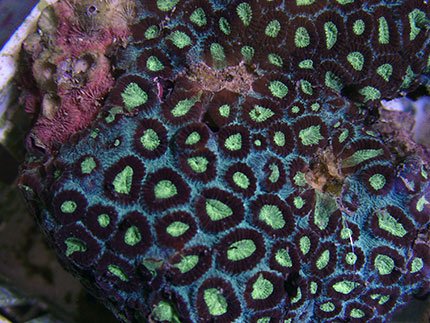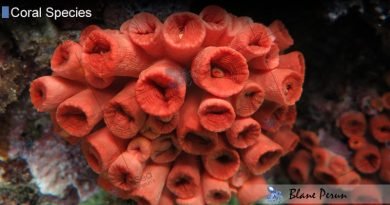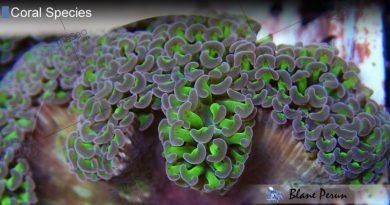Favia
Table of Contents
Favia is a genus of reef building stony corals which belong to the family Mussidae. Members of this genus usually form dome-shaped or oval colonies, with some species earning the name golfball corals. Contrary to the majority of other stony corals, these mostly inhabit the tropical waters of the Atlantic Ocean.
The colonies formed by these species are usually massive, with some species showing encrusting growth patterns. Colonies are either flat or dome-shaped, and in the cases of colonies growing through budding, they make take an oval shape. However, there is great diversity in shapes and sizes depending on species, with variety even in the same species or even the same colony. Some Favia species may be foliaceous, with disc formations. The corallites are usually just a bit higher than the level of the colony, and each corallite usually has its own wall. One corallite may hold one or multiple polyps. The septa and costae of the corallites are well defined and finely toothed, with rather large collumelae. The polyps extend only during the night to feed.
At the outer edges of the colonies, there are also longer tentacles called sweeper tentacles. These are used to “sweep” the waters in search of other corals. If found, these tentacles start to sting and to deter the others from growing in the vicinity. This is called a coral war, and it is used by the corals to ensure that there is sufficient space for their offspring to grow as well as for their own colony growth.
While most other stony corals are specific to the Indo-Pacific region, many species of this genus can usually be found in the Atlantic. Colonies can be found from the Caribbean and the East US coast to the East coast of South America, and to the equatorial waters of West Africa. Some species can also be found in the Indian Ocean, China Sea and West Pacific. These species can be found at depths of up to 30 meters, with colonies growing on coral reefs, in seagrass meadows or even on rocks.
Notable Favia species include F. fragum, F. maritime and F. pallida. F. fragum is also known as the golfball coral, and it can be found on both sides of the Atlantic Ocean in tropical waters. The colonies are hemispherical, with large corallites that are packed together.
Feeding
These corals are zooxanthellae and so a part of their food is generated by the tiny photosynthetic dinoflagellate they live in symbiosis with. The rest of the food comes by filtering nutrients from the water column or catching bacteria or small zooplankton organisms.
These corallites can reproduce via both sexual and asexual reproduction. Asexual reproduction can occur through intra- or extra-tentacular budding, fragmentation and polyp bailout. Sexual reproduction is achieved during synchronous events called spawning events that are specific to each species. During these events, the Favia species release large amounts of eggs and sperm that will fertilize either in the column of water or while the eggs are attached to the parent colony.
Exploring the Fascinating World of Favia Corals
Favia corals, a genus in the family Mussidae, represent some of the most robust and diverse stony corals in the marine world. These reef-building organisms play a pivotal role in their ecosystems, creating habitats for countless marine species. With their unique growth patterns and vibrant colors, Favia corals are not only vital to underwater ecosystems but also highly sought after in the aquarium trade. In this comprehensive guide, we’ll delve into various aspects of Favia corals, from their biology and habitat to their care in captivity.
Biology and Structure of Favia Corals
Understanding Favia Polyp Anatomy
The basic structural unit of Favia corals is the polyp, a small, anemone-like creature. Each polyp in a Favia coral colony is genetically identical and contributes to the growth of the coral skeleton, primarily composed of calcium carbonate. These polyps are interconnected, sharing nutrients and resources across the colony. The polyp’s anatomy includes tentacles, which are used for feeding, and a mouth that doubles as an exit for waste.
Favia Coral Skeleton Growth
Favia corals exhibit a unique growth pattern characterized by the formation of dome-shaped or brain-like structures. This growth is facilitated by the deposition of calcium carbonate, forming a hard, protective skeleton around the soft-bodied polyps. The rate of skeletal growth in Favia species is influenced by various factors, including water temperature, light intensity, and water chemistry. This growth process is integral to reef building, contributing significantly to the structural integrity of coral reefs.
Habitat and Distribution
Native Habitats of Favia Corals
Favia corals are predominantly found in the shallow waters of the Indo-Pacific region, including the Red Sea, the Indian Ocean, and the central and western Pacific Ocean. They thrive in a range of environments, from clear, sunlit reef tops to murky lagoon floors. Favia species adapt to various light and flow conditions, contributing to their widespread distribution in diverse marine ecosystems.
Environmental Conditions for Optimal Growth
The optimal growth of Favia corals occurs in water temperatures ranging from 75 to 82°F (24 to 28°C), with moderate to high light conditions. They require stable water chemistry, with specific levels of calcium, magnesium, and alkalinity to support skeletal growth. Favia corals also benefit from moderate water flow, which aids in nutrient uptake and waste removal, contributing to their overall health and growth.
Favia in Aquariums
Successful Acclimation and Care
Introducing Favia corals into an aquarium requires careful acclimation to prevent shock from sudden environmental changes. Gradual adjustment to the aquarium’s water parameters, lighting, and flow is crucial. Regular monitoring of water chemistry, including nitrates, phosphates, and pH levels, is essential for maintaining the health of Favia corals in captivity.
Common Challenges in Favia Husbandry
One of the primary challenges in keeping Favia corals in an aquarium is managing their aggressive behavior towards other corals. They can extend sweeper tentacles to sting neighboring corals, necessitating careful placement within the tank. Additionally, Favia corals are susceptible to diseases such as coral bleaching and bacterial infections, which require prompt attention and treatment.
Research and Studies on Favia Corals
Scientific Research Contributions
Favia corals have been the subject of numerous scientific studies focusing on coral growth, reproduction, and response to environmental stressors. Research on Favia species contributes to our understanding of coral biology, ecology, and the impacts of climate change on coral reefs. These studies are crucial for conservation efforts and the development of strategies to protect coral reefs globally.
Favia Corals and Climate Change
The resilience of Favia corals to changing environmental conditions has made them a focus of climate change research. Studies have examined their response to increased water temperatures and ocean acidification, shedding light on the potential impacts of climate change on coral reef ecosystems. Understanding the adaptability of Favia corals to these changes is vital for predicting the future of coral reefs under global warming scenarios.
Conclusion
Favia corals are not only a cornerstone of marine biodiversity but also a window into the health of our oceans. Their unique biology, diverse habitats, and adaptability make them a fascinating subject for both hobbyists and scientists. As we continue to explore and understand these remarkable organisms, we can better appreciate their role in our planet’s marine ecosystems and the urgent need to protect them.
FAQs about Favia Corals
1. What are the ideal water conditions for Favia corals in an aquarium? Favia corals thrive in water temperatures between 75 and 82°F, with stable water chemistry. Key parameters include calcium levels around 400-450 ppm, magnesium at 1250-1350 ppm, and alkalinity between 8-12 dKH. Consistent salinity and moderate water flow are also important for their health.
2. How do Favia corals feed? Favia corals are primarily photosynthetic, relying on symbiotic algae, called zooxanthellae, for nutrition. However, they can also capture plankton and small particles from the water using their tentacles. Feeding on microplankton supplements their nutritional needs, especially in an aquarium setting.
3. Can Favia corals be kept with other coral species in an aquarium? Yes, but with caution. Favia corals can be aggressive, extending sweeper tentacles to sting nearby corals. It’s important to provide ample space between Favia and other corals to prevent conflict and ensure the health of all inhabitants.
4. What are some common diseases that affect Favia corals? Favia corals are susceptible to diseases like coral bleaching, where they lose their symbiotic algae due to stress, and bacterial infections. Signs of distress include discoloration, mucus production, and tissue recession. Prompt identification and treatment are crucial.
5. How do Favia corals contribute to the ecosystem? Favia corals play a vital role in reef ecosystems by building and maintaining reef structures, providing habitats for a myriad of marine species. They also contribute to nutrient cycling and carbon fixation, supporting overall marine biodiversity.




